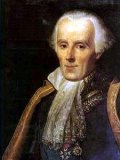Pierre-Simon (Marquis de) Laplace

Pierre-Simon, marquis de Laplace (23 March 1749 - 5 March 1827) was a French mathematician and astronomer and is often called the "French Newton." His masterpiece was Mecanique Celeste which redeveloped and improved Newton's work on planetary motions using calculus. While Newton had shown that the two-body gravitation problem led to orbits which were ellipses (or other conic sections), Laplace was more interested in the much more difficult problems involving three or more bodies. (Would Jupiter's pull on Saturn eventually propel Saturn into a closer orbit, or was Saturn's orbit stable for eternity?) Laplace's equations had the optimistic outcome that the solar system was stable.
Laplace advanced the nebular hypothesis of solar system origin, and was first to conceive of black holes and multiple galaxies. He explained the so-called secular acceleration of the Moon. (Today we know Laplace's theories do not fully explain the Moon's path, nor guarantee orbit stability.) His other accomplishments in physics include theories about the speed of sound and surface tension. He was noted for his strong belief in determinism, famously replying to Napoleon's question about God with: "I have no need of that hypothesis.
Laplace viewed mathematics as just a tool for developing his physical theories. Nevertheless, he made many important mathematical discoveries and inventions, most notably the Laplace Transform. He was the premier expert at differential and difference equations, and definite integrals. He developed spherical harmonics, potential theory, the theory of determinants, and advanced Euler's technique of generating functions. In the fields of probability and statistics he made important advances: he proved the Law of Least Squares, and introduced the controversial ("Bayesian") rule of succession. In the theory of equations, he was first to prove that any polynomial of even degree must have a real quadratic factor.
Others might place Laplace higher on the list, but he proved no fundamental theorems of pure mathematics (though his partial differential equation for fluid dynamics is one of the most famous in physics), founded no major branch of pure mathematics, and wasn't particularly concerned with rigorous proof. (He is famous for skipping difficult proof steps with the phrase "It is easy to see".) Nevertheless he was surely one of the greatest applied mathematicians ever.
Source: Wikipedia

